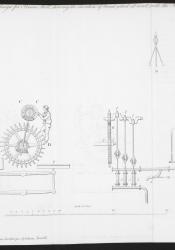Brixton Prison
Brixton Prison was one of the first major prisons to adopt the use of the tread mill as a form of punishment for inmates. The prison was opened in 1820, shortly after the tread mill was invented in 1818. It did not take long for opponents of the tread mill to publish pamphlets arguing that its usage could amount to a form of torture. As John Ivatt Briscoe writes, in his A Letter on the Nature and Effects of the Tread-Wheel, as an instrument of prison labour and punishment, addressed to the Right Hon. Robert Peel, "It is perfectly true, that the labour of the Tread-wheel, unless it be regulated with great care, may, to use the language of an able and experienced Govenor of a Prison (in recent communication with the Committee) become, in the hands of some, AN ENGINE OF TERRIBLE OPPRESSION. Fifth Report of the Committee of the Society for the Improvement of Prison Discipline, pg. 36)" (British Library, "A Letter on the Nature and Effects of the Tread Wheel," https://www.bl.uk/collection-items/a-letter-on-the-nature-and-effects-of-the-tread-wheel).
Coordinates
Longitude: -0.125168000000

